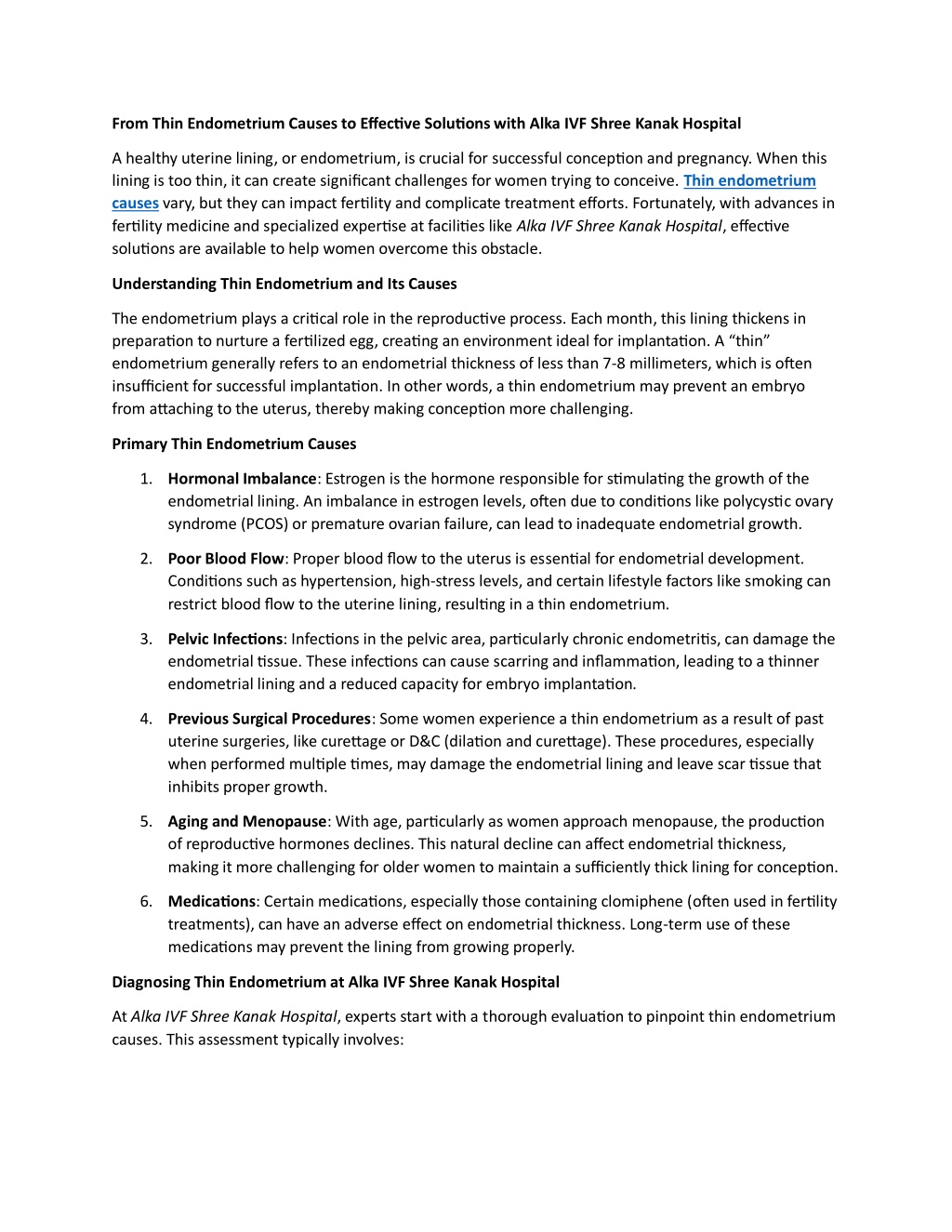
From Thin Endometrium Causes to Effective Solutions 14 november
thin endometrium causes
Download Presentation

Please find below an Image/Link to download the presentation.
The content on the website is provided AS IS for your information and personal use only. It may not be sold, licensed, or shared on other websites without obtaining consent from the author. Download presentation by click this link. If you encounter any issues during the download, it is possible that the publisher has removed the file from their server.
E N D
Presentation Transcript
From Thin Endometrium Causes to Effective Solutions with Alka IVF Shree Kanak Hospital A healthy uterine lining, or endometrium, is crucial for successful conception and pregnancy. When this lining is too thin, it can create significant challenges for women trying to conceive. Thin endometrium causes vary, but they can impact fertility and complicate treatment efforts. Fortunately, with advances in fertility medicine and specialized expertise at facilities like Alka IVF Shree Kanak Hospital, effective solutions are available to help women overcome this obstacle. Understanding Thin Endometrium and Its Causes The endometrium plays a critical role in the reproductive process. Each month, this lining thickens in preparation to nurture a fertilized egg, creating an environment ideal for implantation. A thin endometrium generally refers to an endometrial thickness of less than 7-8 millimeters, which is often insufficient for successful implantation. In other words, a thin endometrium may prevent an embryo from attaching to the uterus, thereby making conception more challenging. Primary Thin Endometrium Causes 1.Hormonal Imbalance: Estrogen is the hormone responsible for stimulating the growth of the endometrial lining. An imbalance in estrogen levels, often due to conditions like polycystic ovary syndrome (PCOS) or premature ovarian failure, can lead to inadequate endometrial growth. 2.Poor Blood Flow: Proper blood flow to the uterus is essential for endometrial development. Conditions such as hypertension, high-stress levels, and certain lifestyle factors like smoking can restrict blood flow to the uterine lining, resulting in a thin endometrium. 3.Pelvic Infections: Infections in the pelvic area, particularly chronic endometritis, can damage the endometrial tissue. These infections can cause scarring and inflammation, leading to a thinner endometrial lining and a reduced capacity for embryo implantation. 4.Previous Surgical Procedures: Some women experience a thin endometrium as a result of past uterine surgeries, like curettage or D&C (dilation and curettage). These procedures, especially when performed multiple times, may damage the endometrial lining and leave scar tissue that inhibits proper growth. 5.Aging and Menopause: With age, particularly as women approach menopause, the production of reproductive hormones declines. This natural decline can affect endometrial thickness, making it more challenging for older women to maintain a sufficiently thick lining for conception. 6.Medications: Certain medications, especially those containing clomiphene (often used in fertility treatments), can have an adverse effect on endometrial thickness. Long-term use of these medications may prevent the lining from growing properly. Diagnosing Thin Endometrium at Alka IVF Shree Kanak Hospital At Alka IVF Shree Kanak Hospital, experts start with a thorough evaluation to pinpoint thin endometrium causes. This assessment typically involves:
Ultrasound Monitoring: Through transvaginal ultrasound, the thickness of the endometrial lining is monitored during the menstrual cycle. This test can reveal if the lining is responding properly to hormonal changes. Hormone Level Testing: Estrogen, progesterone, and other hormones that affect the endometrium are measured to determine if an imbalance could be the root cause. Hysteroscopy: This procedure allows doctors to view the inside of the uterus and identify any structural abnormalities, such as scar tissue, that may be contributing to thin endometrium. Endometrial Biopsy: In cases where infection or chronic inflammation is suspected, a biopsy may be conducted to assess the tissue for signs of infection or other cellular abnormalities. Effective Treatment Options Available at Alka IVF Shree Kanak Hospital Once the causes of thin endometrium have been identified, specialists at Alka IVF Shree Kanak Hospital work with patients to develop tailored treatment plans. These plans may include one or more of the following solutions: 1. Hormonal Therapy For patients whose thin endometrium results from hormonal imbalance, estrogen supplementation is often recommended. Estrogen therapy, delivered through oral medications, patches, or injections, can stimulate endometrial growth and improve its thickness. In many cases, estrogen is combined with progesterone to further support the development of a healthy lining. 2. Blood Flow Improvement Techniques To increase blood flow to the uterus, patients may be advised to adopt lifestyle changes such as regular exercise, stress reduction techniques, and dietary adjustments. Additionally, acupuncture is sometimes used to boost circulation to the pelvic region, potentially enhancing endometrial growth. 3. Low-Dose Aspirin and Other Medications In some cases, low-dose aspirin may be prescribed to improve blood flow to the uterus. By enhancing circulation, aspirin may support endometrial growth. Other medications, like sildenafil (Viagra), have also been explored in thin endometrium cases for their potential to increase blood flow to the uterine lining. 4. Stem Cell Therapy and PRP (Platelet-Rich Plasma) Alka IVF Shree Kanak Hospital stays at the forefront of advanced fertility treatments, including stem cell therapy and PRP. In this treatment, PRP is injected directly into the uterus to stimulate endometrial cells and promote growth. Similarly, stem cell therapy introduces regenerative cells that can repair and rejuvenate endometrial tissue, helping women with severe cases achieve a healthier uterine lining. 5. Lifestyle and Nutritional Support Incorporating proper nutrition and stress management into a patient s lifestyle plan can make a difference in the overall health of the endometrium. Patients at Alka IVF Shree Kanak Hospital receive counseling on dietary choices rich in omega-3 fatty acids, vitamins, and antioxidants that can improve uterine health.
6. Customized IVF Protocols For patients who require assisted reproductive technology (ART) to conceive, Alka IVF Shree Kanak Hospital customizes IVF protocols to account for thin endometrium issues. This approach may involve adjusting hormone levels, incorporating endometrial scratching, or using embryo transfer techniques that are more favorable to women with thin endometrium. Why Choose Alka IVF Shree Kanak Hospital? Alka IVF Shree Kanak Hospital is dedicated to supporting women with all types of fertility challenges, including thin endometrium causes. With a comprehensive approach to diagnosis, state-of-the-art treatments, and a highly experienced team, Alka IVF Shree Kanak Hospital provides compassionate care tailored to each patient's needs. The hospital s multidisciplinary approach means that patients benefit not only from advanced fertility treatments but also from a holistic care environment that addresses all aspects of reproductive health. Conclusion A thin endometrium can be a significant hurdle in the journey toward conception, but with the right support and treatment options, it is a challenge that can often be overcome. At Alka IVF Shree Kanak Hospital, women struggling with thin endometrium causes receive expert care and access to the latest advancements in fertility treatment. With personalized treatment plans and a focus on understanding and addressing individual needs, Alka IVF Shree Kanak Hospital offers hope and effective solutions for women looking to build their families.






















